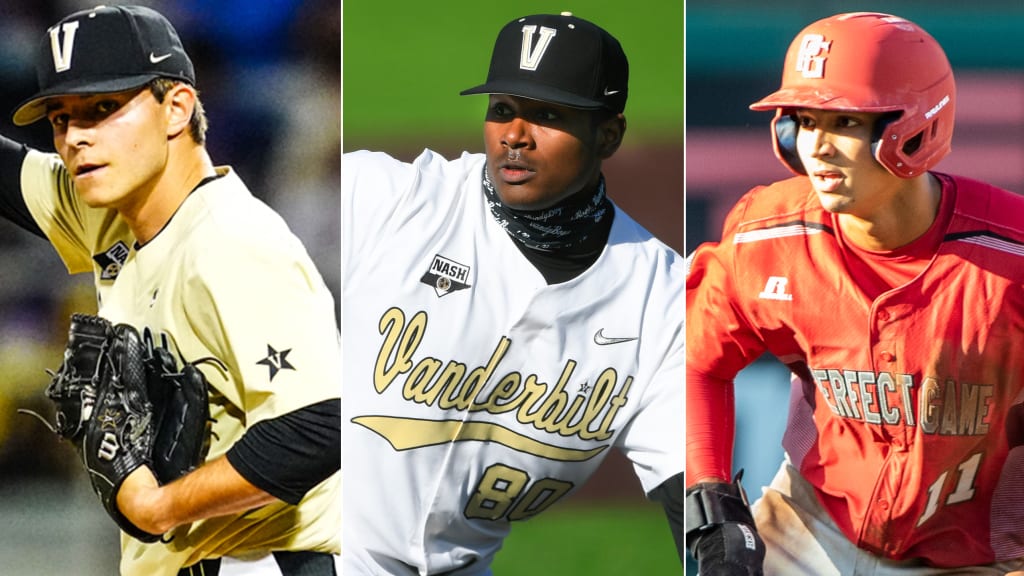
I am immersed in the 2021 Draft right now and enjoying every minute. I had a lot of fun getting scouts to compare Vanderbilt aces Jack Leiter and Kumar Rocker and am enjoying a deep dive into my half of the country as we work on our new Draft Top 150 list, which will be out in a couple of weeks. So let's keep that rolling with an all-Draft edition of the Pipeline Inbox...
Would Jack Leiter be the smallest pitcher ever to get drafted 1st overall if he is the first pick?
-- @JaySanchez1
Not quite. Leiter is listed at 6-foot-1 and 205 pounds, which would match David Clyde (1973) and Floyd Bannister (1976) as the shortest pitchers ever selected No. 1 overall. Both Clyde (180 pounds) and Bannister (185), the first two hurlers taken that high, weighed less than Leiter.
Rocker, who's 6-foot-4 and 245 pounds, would be the heftiest pitcher ever to go No. 1, surpassing 230-pounder Andy Benes (1988). The tallest ever is 6-foot-7 Ben McDonald (1989). The average of the 18 arms taken at 1-1 is 6-foot-4 and 207 pounds.
With Jack Leiter and Kumar Rocker dominating the SEC and Vanderbilt commit Jordan Lawlar the odds-on favorite to be the top high school player drafted, has there ever been a school whose players and commits went 1-2-3?
-- @AndrewVU04
Leiter, Rocker and Dallas prep shortstop Lawlar are three of the four names in the current top tier of 2021 Draft prospects, along with California high school shortstop Marcelo Mayer. It's very possible that Leiter, Lawlar and Rocker could go 1-2-3 in July.
College commitment information isn't easy to locate for the early years of the Draft, but I was able to find at least four instances where one school had two players or recruits among the top three picks in a June Draft:
Arizona State, 1978 -- 3B Bob Horner (No. 1), SS Hubie Brooks (No. 3)
UCLA, 1979 -- RHP Tim Leary (No. 2), recruited C Jay Schroeder (No. 3)
North Carolina, 2009 -- OF/2B Dustin Ackley (No. 2), recruited OF Donavan Tate (No. 3)
UCLA, 2011 -- RHP Gerrit Cole (No. 1), RHP Trevor Bauer (No. 3)
Schroeder actually signed with the Blue Jays with the provision he could play quarterback at UCLA. He gave up football two years later to focus on baseball, but he never could solve pro pitching and topped out in High-A. The Washington Redskins took him in the third round of the 1984 NFL Draft and he made one Pro Bowl in 10 seasons with four teams.
Could you see Jordan Lawler falling to No. 5? Who could go before him?
-- @brucehartman23
Lawlar's 16 strikeouts in his first 93 plate appearances this spring are somewhat baffling to scouts, with that 17 percent whiff rate in high school much higher than expected from a potential No. 1 overall choice. He's still a potential five-tool shortstop, so I can't imagine him lasting until the fifth pick in what is shaping up as a below-average Draft.
Lawlar draws parallels to fellow Dallas-area shortstop Bobby Witt Jr., who had some swing-and-miss concerns in 2019 but still went No. 2 overall to the Royals and looked sensational in big league camp this spring. When I was researching the Leiter vs. Rocker story and asked clubs who they would take if they had the first choice, Lawlar received nearly as many mentions as Leiter.
"If the Draft were today, last week or three months from now," a National League scouting official said, "I'd take Jordan Lawlar 1-1 and sleep pretty good."
Should Henry Davis be in the mix for the No. 1 pick?
-- @NorbertoPaulino
In a year in which most of the potential first-round college hitters have disappointed, Louisville catcher Davis and Boston College outfielder Sal Frelick are the two exceptions. Davis is batting .390/.496/.700 with more extra-base hits (15, including eight homers) and walks (18) than strikeouts (10) through 27 games. He also has used his plus-plus arm to throw out half of the 18 would-be basestealers who have tested him.
At this point, Davis would go in the top half of the first round but No. 1 overall is too rich. He doesn't have a pretty right-handed swing though he does make repeated hard contact, and the biggest issue would be his defense behind the plate. Most scouts grade him as a below-average to fringy receiver and wonder if he might be better (and provide even more offense) in the big leagues as a right fielder, and those concerns will keep him out of the first few selections.
